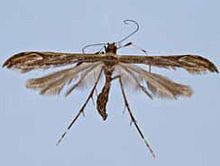Oidaematophorus beneficus
| Hellinsia beneficus | |
|---|---|
 |
|
| Scientific classification | |
| Kingdom: | Animalia |
| Phylum: | Arthropoda |
| Class: | Insecta |
| Order: | Lepidoptera |
| Family: | Pterophoridae |
| Genus: | Hellinsia |
| Species: | H. beneficus |
| Binomial name | |
|
Hellinsia beneficus (Yano & Heppner, 1983) |
|
| Synonyms | |
|
|
Hellinsia beneficus is a moth of the Pterophoridae family. It is native to Mexico, but was introduced to Hawaii in 1959 and 1965 (unsuccessful) and 1973 (successful) for the biological control of mistflower.
The wingspan is 22–28 mm. The forewings are brown‑grey at the costa and near the base. The markings are dark brown. The hindwings are brown‑grey. Adults are on wing in February and July, at an altitude of 450 to 1,350 metres (1,480 to 4,430 ft).
The larvae feed on Ageratina riparia. Pupation takes place on leaves or in litter at the base of the plant or on the stem.
...
Wikipedia
